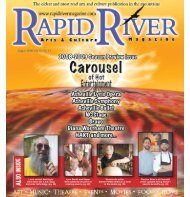JOHN MAC KAH - Rapid River Magazine
JOHN MAC KAH - Rapid River Magazine
JOHN MAC KAH - Rapid River Magazine
You also want an ePaper? Increase the reach of your titles
YUMPU automatically turns print PDFs into web optimized ePapers that Google loves.
R A P I D R I V E R A R T S & C U L T U R E<br />
thoreau’s garden<br />
Prehistoric Plants: Jurassic Park in Your Backyard!<br />
Some 250 million years ago wasn’t<br />
exactly a great time to be a gardener.<br />
Sure plants existed—there were lots<br />
of plants—but stepping around the<br />
wildlife that walked over and on the<br />
plants—not to mention the pterodactyls that<br />
flew above—would make dealing with deer<br />
and woodchucks, (not to mention rabbits<br />
and moles), easy as pie. And we overlook<br />
persistent volcanoes, earthquakes, swamps,<br />
storms, and generally very hot weather.<br />
So what was growing when T-Rex and<br />
his buddies were walking the earth during<br />
the Mesozoic Era? Well, there were the<br />
leftovers of the Carboniferous Period (some<br />
300 million years—or more—ago), including<br />
plants like our everyday mosses, the odd<br />
and wonderful horsetails, plus a bevy of<br />
ferns (both low to the ground and some as<br />
tall as trees).<br />
BY PETER LOEWER<br />
I live next door to a moss garden that<br />
is more beautiful than any lawn could ever<br />
hope to be. It’s a shaded retreat cared for by<br />
neighbor John Cram and made of mosses<br />
like pincushion moss (Leucobryum longifolium)<br />
or the triangular<br />
wood-reveler (Hylocomnium<br />
triquetrum), mosses<br />
that drink the morning dew<br />
and only ask that leaves<br />
from overhanging trees are<br />
raked up before the mosses<br />
become dormant in late fall.<br />
Majella LaRochelle, an<br />
old garden friend now living<br />
in Canada, actually planned<br />
a small moss garden about<br />
the size of a closet door, and<br />
using interesting stones, bits<br />
of wood, and errant seedlings<br />
of other forest plants,<br />
created a miniature landscape<br />
only lacking wee<br />
elves to walk the shaded<br />
pathways.<br />
When growing<br />
horsetails, remember<br />
you need a contained<br />
area (these wonders<br />
are pernicious spreaders) for a plant<br />
that looks like a miniature model of a<br />
Carboniferous plant that once grew over<br />
fourteen feet high and often became a<br />
place where dragonflies with 20-inch<br />
wingspans looked out for other insects<br />
to have for dinner. The single extant<br />
genus Equisetum is truly prehistoric in<br />
form and history, actually looking like<br />
a stem made of ridged and greenish<br />
pop-its, bearing no seeds or flowers but<br />
reproducing with spores.<br />
The most common species is<br />
Equisetum hyemale, found growing along<br />
streams, lakes, ditches, and the edges of old<br />
railroad beds. Because the horsetails have<br />
a high silica content, they were often used<br />
to clean and polish pots and pans—railroad<br />
READING BY GREAT SMOKIES REVIEW AUTHORS<br />
T<br />
he Spring 2011 issue of The Great<br />
Smokies Review, a web-based literary<br />
magazine published by UNC<br />
Asheville’s Great Smokies Writing<br />
Program (GSWP), is now online at www.<br />
thegreatsmokiesreview.org.<br />
This fourth issue begins with Editor<br />
Elizabeth Lutyens’ musings on writing<br />
about place, and then takes readers on<br />
a literary journey through the one-lane<br />
Carolina roads of GSWP Executive<br />
Director Tommy Hays’ boyhood, and<br />
then makes stops in the North Slope of<br />
Alaska, Sichuan, China, and colonial-era<br />
Massachusetts. Readers will view the<br />
Cretaceous Period through the eyes of a<br />
hasty time-traveler, and visit a suburban<br />
house that a grieving mother refuses to<br />
leave. This issue also includes an interview<br />
by Nancy Russell-Forsythe with<br />
popular novelist and GSWP instructor<br />
Vicki Lane. “We are growing new layers<br />
within the creative writing community,”<br />
says Hays. “The Great Smokies Review<br />
is a forum for discussion and learning as<br />
well as a place for good work.”<br />
IF YOU GO: Contributors from the Fall<br />
and Spring issues will present a reading<br />
of their works at 3 p.m. Sunday, May<br />
15, at Malaprop’s Bookstore & Café, 55<br />
Haywood St., in Asheville. The reading<br />
is free and open to the public.<br />
Illustrations by Peter Loewer<br />
cooks then threw their spent<br />
green scouring pads out of<br />
the caboose and that’s why<br />
they frequent railroad beds.<br />
Horsetails have a stark,<br />
architectural beauty all their<br />
own and look especially fine<br />
in combination with ferns<br />
or alone at the water’s edge.<br />
The tiny pennants that<br />
circle the rings, which in<br />
turn section off the stems,<br />
are primitive, scale-like<br />
leaves so the major part of<br />
photosynthesis occurs in<br />
the stem. Individual stem<br />
sections can be pulled apart<br />
and if pushed into damp<br />
sand or other growing medium,<br />
will root.<br />
And if you like small<br />
horsetails, look for Equisetum<br />
scirpoides, or the dwarf<br />
scouring rush, found at the<br />
edges of coniferous woods<br />
from Greenland south<br />
down to North Carolina.<br />
The threadlike stems reach a height of<br />
about nine inches.<br />
Let’s wind up our list of prehistoric<br />
plants with a visit to Ancient Egypt (ignoring<br />
the plagues) and Egyptian papyrus (Cyperus<br />
papyrus) probably the youngest plant (in<br />
geologic time) on our list. Likened to a grass,<br />
papyrus is really a sedge easily identified as<br />
such having a triangular instead of a round<br />
stem. The plant’s history began in the Mid-<br />
Cretaceous Period some 65 million years ago.<br />
By summer’s end in our mountain<br />
garden, the flowering stems reach a height<br />
of ten to twelve feet, with each stem topped<br />
by a circle of leaves (really bracts) and dense<br />
clusters of bright green stalks. Unromantic<br />
folk would say they resemble a feather<br />
duster while romantics liken them to the<br />
fans probably used to cool Cleopatra on her<br />
journeys up and down the Nile <strong>River</strong>. With<br />
the heat of summer the stalks bear clusters<br />
of spikelets (really flowers).<br />
So now Carolina gardeners can grow<br />
plants that once fed herds of brontosauruses<br />
or were buried under volcanic lava and<br />
ash, not to mention the paper used to write<br />
down The Egyptian Book of the Dead.<br />
Peter Loewer,<br />
shown here,<br />
examining the<br />
blossoms of<br />
early-blooming<br />
Lenten roses,<br />
is a wellknown<br />
writer<br />
and botanical artist who has written and<br />
illustrated more than twenty-five books on<br />
natural history over the past thirty years.<br />
28 May 2011 — RAPID RIVER ARTS & CULTURE MAGAZINE — Vol. 14, No. 9
















